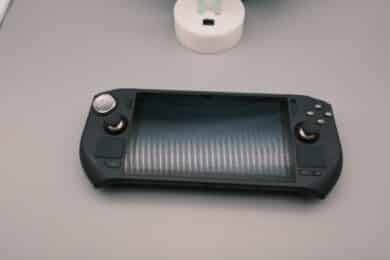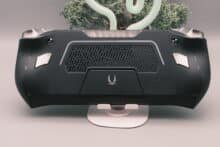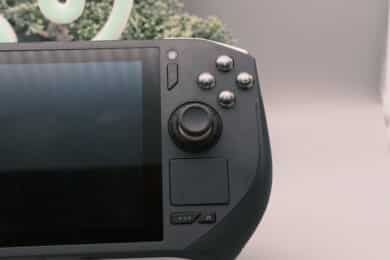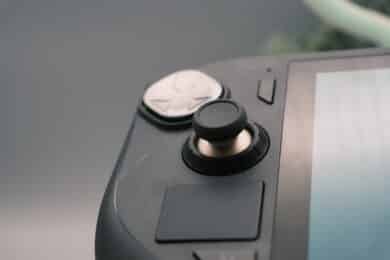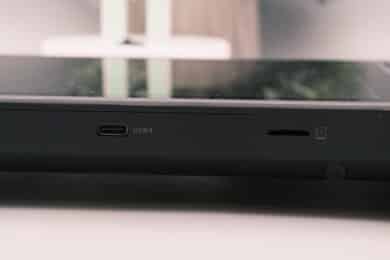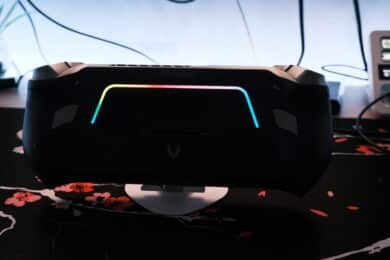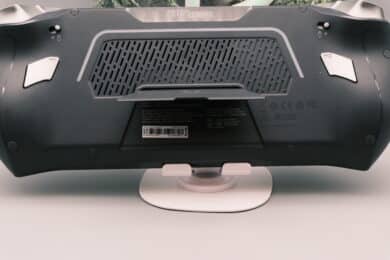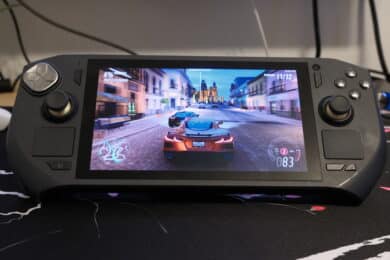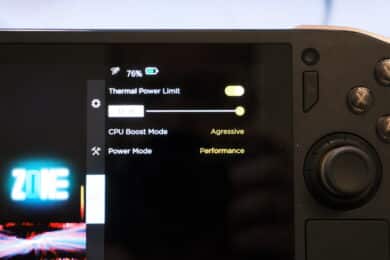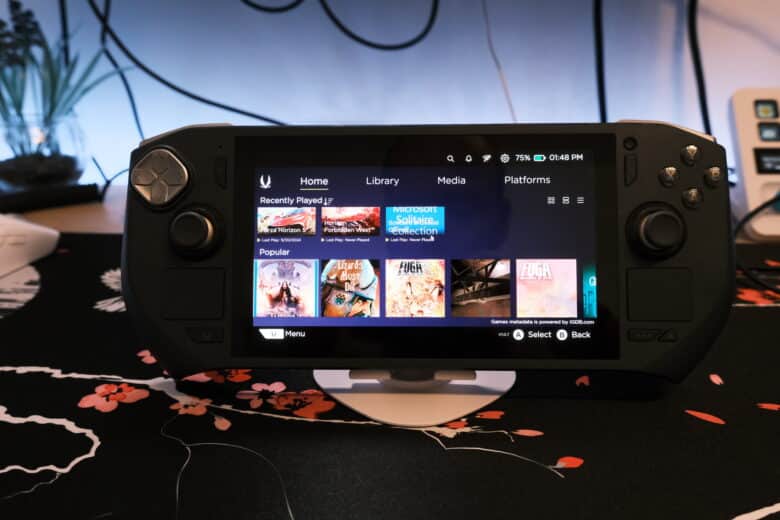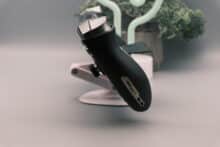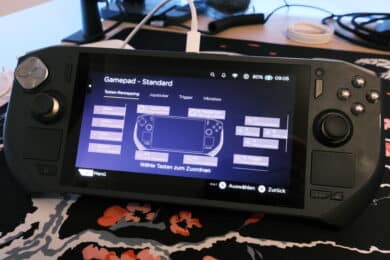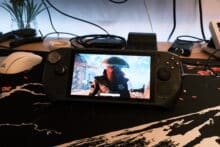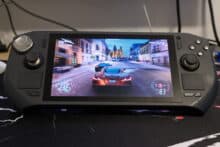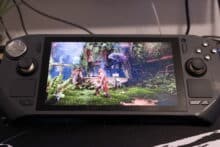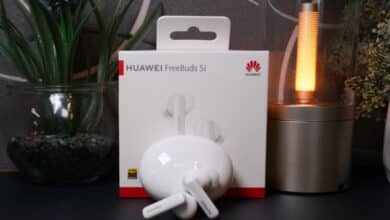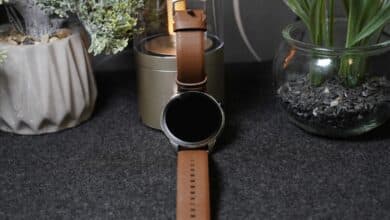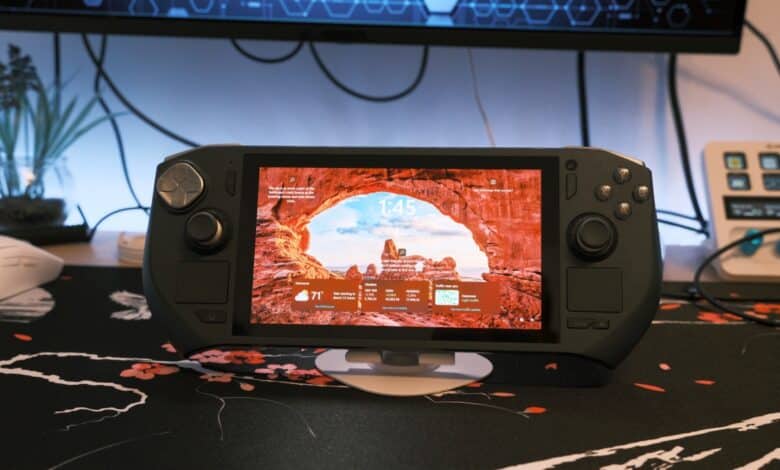
Nowadays, pretty much every peripheral manufacturer wants a slice of the gaming handheld pie, but there hasn’t been a really serious competitor for the Steam Deck OLED (our review) until now. The Zotac Zone is now another Steam Deck alternative. And with a bright 120 Hz AMOLED display, great controls and some innovative features, it has a lot to offer. Our test reveals more.
Technical data
| The product | Zone |
| Display | AMOLED panel |
| Display resolution | 1,920 x 1,080 pixels |
| Screen size | 7.0 inch |
| Touch screen | Yes |
| Refresh rate | 120 Hertz |
| Brightness | Up to 5800 nits (SDR) |
| Chipset | AMD Ryzen 7 8840U CPU: 8x AMD Zen 4 with up to 5.1 GHz GPU: AMD Radeon 780M, 12 cores |
| RAM | 16 GB LPDDRX5 RAM (7,500 MT/s) |
| System memory | 512 GB NVMe SSD (PCIe 4.0) |
| Bluetooth | Bluetooth 5.2 |
| Wi-Fi | WiFi 6E |
| Audio | Stereo speaker |
| rechargeable battery | 48.5 watt hours |
| Connections | USB Type-C; 3.5 mm jack; microSD card slot |
| dimensions | 285 x 115 x 35 mm |
| weight | 692 grams |
| Price | € 867.43 * |
Zotac Zone test: But it feels good in the hand
- elegant design
- excellent ergonomics
- comparatively heavy
The fact that Valve’s Steam Deck is still the undisputed champion among PC gaming handhelds, despite its outdated hardware, is due in part to its outstanding ergonomics, which neither ASUS ROG nor Lenovo and the like can match.
The Zotac Zone manages this much better. And this despite the fact that the gaming handheld weighs 693 grams, which is more than most of its competitors. Surprisingly, thanks to the 7-inch AMOLED display, the dimensions of 285 x 115 x 35 mm are even noticeably smaller than the Steam Deck.
With its grey color scheme and the silver and gold details on the top and sides, the gaming handheld looks great and feels great in the hand thanks to the rubberized and generous grips. The weight is very well balanced, which is why you can hold the Zone in your hands for hours without any problems.
The build quality is very good, but the grey anodized housing quickly attracts fingerprints. In addition, our test model already has a few minor scratches and smudges. However, this is nothing to criticize, who knows what kind of hands the device has been through.
Excellent controls
- Precise, tactile controls
- practical trackpads, but…
- … Mouse operation somewhat imprecise
In terms of design, the Zone is reminiscent of the Valve model and features two trackpads to the left and right of the display, for example, which can be used to scroll through the menus and operate a mouse pointer. There are also the classic control elements of buttons, two analog sticks, triggers and bumpers.
Practical: There is a USB-C port at the top and bottom in the modern USB4 standard. The 512 GB storage (which, by the way, is available as an M.2-2280 SSD, making it easier to replace) can also be expanded at the bottom using a microSD card.
At the top, you will also find the power button (which incidentally has an integrated fingerprint sensor for Windows Hello login), the two volume buttons and a 3.5 mm jack to connect the handheld to headphones. In addition to the other buttons on the front, the Zone even has a webcam. But whether you really need it, even considering the limited quality, is another matter.
The back of the Zone is also interesting, as it features RGB lighting and a small kickstand that is reminiscent of the one on the Nintendo Switch. Practical if you want to place the handheld on the table and use it with a controller.
There are also two additional programmable macro buttons and two trigger stops, which can be used to shorten the path of the LT and RT triggers. Very practical when playing shooters, for example. Especially as the two triggers are pleasantly clicky and precise in the shortened path.
In general, the Zotac Zone deserves high praise for its controls. They feel very precise and trigger very accurately. The triggers and analog sticks also use a reverb effect, which should prevent stick drift problems. The D-pad (control pad) triggers mechanically, which is a real advantage, especially in fighting games.
The trackpads also prove to be very useful in the Windows 11 interface. The one on the right mimics a mouse. Depending on whether you press left or right on the surface, this triggers the click of the left or right mouse button. However, the mouse pointer is a little too sensitive for me, which is why it is not uncommon to click past the actual target.
With the left trackpad, on the other hand, you can scroll up and down or left and right through various menus.
What annoyed me a little, however, is that the operation is not the same in all menus. I can use the touchscreen and mouse on the desktop, and the sticks, D-pad and ABXY buttons are also available in the ONE Launcher app. In the quick settings “…” button, however, only the trackpad and touchscreen work. So you have to keep changing your grip when switching between menus.
Top OLED display in the Zone
- Excellent OLED display
- 800 nits brightness
- 1080p with 120 Hz
Fortunately, Zotac relies on an OLED display for the Zone, just like Valve for the Steam Deck OLED. The deep blacks and bright colors are already very positive after the first switch-on, whereas many competitors use a rather pale IPS panel.
The 7-inch screen is pleasantly bright at 800 nits, which also makes it very easy to read outdoors. At 1,920 x 1,080 pixels, it also has a noticeably higher resolution than the Steam Deck OLED and achieves a smooth refresh rate of 120 hertz.
If you like, you can also reduce the resolution to 1,440 x 900 pixels in the quick settings. This is of course ideal for graphically demanding titles if you want to tease out a higher level of detail.
Unfortunately, there is no VRR (Variable Refesh Rate) support, which would have been the icing on the cake. However, I didn’t really miss it in the test. On the other hand, the multi-touch screen is also very precise when it comes to triggering and can even display HDR content.
Alongside the Steam Deck OLED, the Zotac Zone currently offers the best display in a gaming handheld.
Features, hardware and battery
- Modern CPU and GPU
- up to 30 watts TDP
- Wi-Fi 6E
The Zotac Zone is also currently ahead in terms of features in the PC gaming handheld sector. The manufacturer has equipped the device with the latest AMD Ryzen 7 8840U chip, which comes with 8 cores, 16 threads and clock speeds of up to 5.1 GHz.
According to the manufacturer, the CPU can consume between 15 watts and 28 watts TDP. However, this value can be freely adjusted between 8 watts and 30 watts in the settings. You can also select various CPU boost and power modes here, allowing you to adjust the handheld to the maximum possible performance, best energy efficiency or something in between.
We have already seen for ourselves in various tests that the built-in iGPU in the form of the AMD Radeon 780M is one of the fastest integrated graphics chips. Added to this is 16 Gbytes of fast DDR5X-7500 RAM, which speaks for strong gaming performance.
Other features include fast Wi-Fi 6E and Bluetooth 5.2 if you want to pair the Zone with a wireless controller or your Bluetooth headphones. The manufacturer has also equipped the handheld with two stereo speakers, which are pleasantly loud and offer a decent sound. There is also a built-in microphone if you want to make video calls or similar.
Battery, cooling and volume
- Disappointing battery life
- very good cooling
- Quite loud under load
The battery of the Zotac Zone has a capacity of 48.5 watt hours and can be charged with a maximum of 65 watts at both the upper and lower USB4 ports. In terms of capacity, it is therefore not quite enough for a top value and the battery life remains the Achilles’ heel of the gaming handheld (and handhelds in general).
Depending on the setting, the device naturally runs out of juice faster or slower. In “Performance” mode with a full 30 watt TDP, it runs out of juice after just over 2 hours. With really intensive titles such as Cyberpunk 2077 or Control, it can even run out of juice in less than an hour.
But even when the power is reduced to 20 watts, the runtime remains meagre. If you mainly want to play at home on the sofa, this is unlikely to bother you. On the move, however, the Zone quickly runs out of breath.
On the other hand, the cooling system does an excellent job. Cool air enters the inside of the handheld via the ventilation slots at the back, and the warm air is then blown out of the housing at the top. Far away from your own hand, the design therefore seems well thought out, especially as the handles remain pleasantly cool.
The CPU and GPU heat up noticeably under load, but the temperatures do not reach worryingly high levels. So you don’t have to worry about a temperature-related reduction in performance.
However, the Zone also gets noticeably loud in 30-watt mode during continuous gaming action, while the noise development is still acceptable at 20 watts. I measured a peak of around 52 dB(A) at 30 watts, which can be quite annoying for those around you. I would recommend the use of headphones anyway.
Zotac Zone: Gaming and practical test
- Operation not uniform
- Practical ONE Launcher
The Zotac Zone uses Windows 11 Home as its operating system and acts like a classic notebook or tablet within the OS. This means that you can start and close apps via the classic Windows taskbar, access the Windows settings, adjust the background image and much more, while installed apps and games are stored on the desktop.
Fun fact: the handheld often hides the taskbar automatically to display more screen space. The taskbar is only displayed when you move the mouse pointer to the position at the bottom of the screen. But not always. Sometimes it remains permanently active. Huh?
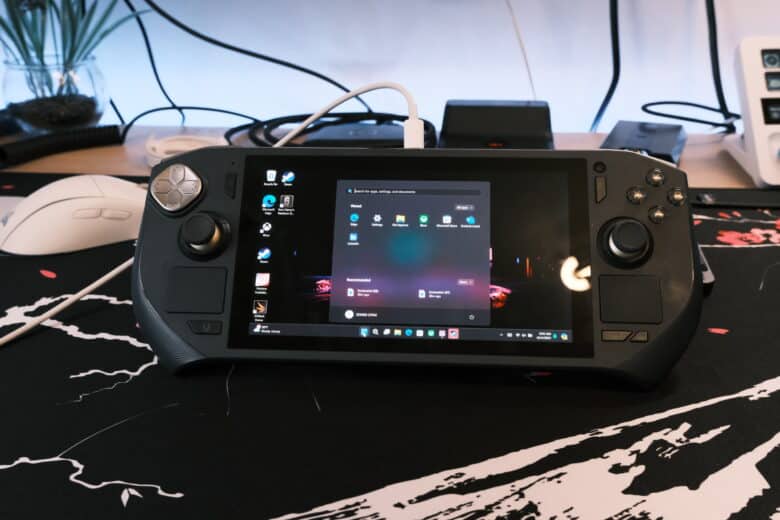
Nevertheless, the operation works flawlessly. The Zotac ONE Launcher, which can also be called up by pressing the Zotac button to the left of the screen, proves to be practical. As the name suggests, the launcher integrates all settings (e.g. for language, display, screen or Bluetooth) as well as all platforms such as Steam, GOG Galaxy or Xbox in one tool.
In addition, extensive settings can be made in the Performance tab and even different profiles can be created, between which you can quickly switch back and forth. Even the fan curves can be freely adjusted, while you can freely adjust the controls in the Gamepad section. I really like the software, even if the German translation on our test model was a little clunky.
Gaming test and benchmarks
- Sufficient power for 1080p on medium details
- Performance hardly stronger than the competition
In terms of gaming performance, the Zotac Zone does a good job. Even more demanding games such as Cyberpunk 2077, Horizon Forbidden West or Forza Horizon 5 are rendered smoothly by the gaming handheld in 1080p and at medium details.
The performance is roughly on par with the AMD Ryzen Z1 Extreme, which can be found in the ASUS ROG Ally, among others. In the most demanding Cyberpunk 2077, the Zone achieves a frame rate of 41 FPS and Shadow of the Tomb Raider can also be played smoothly at 40 FPS.
Both values apply to the 30-watt mode in the performance profile Performance, a reduction to 25 watts makes no difference in terms of performance, but if you go down to 20 watts, the performance drops noticeably – but you get around 1-2 hours more battery life.
| Benchmark | Zotac Zone, 1080p, medium details |
| 3DMark Fire Strike | 7,871 points |
| 3DMark Time Spy | 3,407 points |
| 3DMark Steel Nomad | 625 points |
| 3DMark Steel Nomad Light | 2,824 points |
| Cyberpunk 2077 | 41 FPS |
| Shadow of the Tomb Raider | 40 FPS |
| Forza Horizon 5 | 61 FPS |
The games benefit noticeably from the excellent 120 Hz AMOLED display of the Zotac Zone, which conjures up wonderful colors and contrasts on the screen. Although the Zone can hardly stand out from the competition in terms of performance, the games look best here thanks to the display.
Zotac Zone review: Conclusion
The Zotac Zone is a really good gaming handheld and, not least thanks to the bright and 120 Hz AMOLED display and the high-performance AMD Ryzen chips, is perhaps currently the strongest alternative to the Steam Deck OLED.
In my test, I found the software, in which all launchers and games can be easily selected, to be practical. Even if navigating the normal Windows 11 UI on the compact display can sometimes be a little tricky, it’s nice that most games can be started easily via the launcher.
Nevertheless, I prefer the intuitive operation of the Steam Deck, where everything simply feels better balanced than with the competition, where I have to navigate through the launcher, Windows and more using various input methods.
The input devices are a unique selling point. The buttons as well as the analog sticks and triggers provide excellent feedback and are almost reminiscent of professional controllers in terms of their precision and pressure feel.
However, the biggest criticism remains the battery capacity and runtime. If you want to play really intensive games, you will have to recharge the device after 1-2 hours. That’s not really mobile. No wonder that the new generation of handhelds such as the ASUS ROG Ally X now go up to 80 Wh.
The price at market launch of around 800 euros is also steep – although not higher than the competition at launch. However, this is unlikely to be sustainable. The Zotac Zone is a really interesting gaming handheld, especially if the price drops.
Zotac Zone
Design & Workmanship
Hardware
Display
Performance
Battery
Value For Money
88/100
The Zone scores with a great AMOLED display and precise input devices and delivers convincing performance, but cannot stand out from the competition in terms of performance and battery life.




